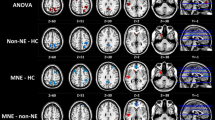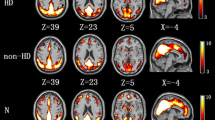Abstract
To investigate functional connectivity (FC) changes in end-stage renal disease (ESRD) patients with and without cognitive impairment (CI) by using resting-state functional magnetic resonance imaging (rs-fMRI). Twenty-three ESRD patients with CI, 22 ESRD patients with non-CI (NCI) and 23 matched healthy controls (HC) were included. Rs-fMRI scans were performed in all subjects. Full-range, long-range, and short-range FC defined voxel-wise based degree centrality (DC) and seed based FC were computed and contrasted among the groups. Compared with HC, the DC value of short functional connectivity (SFC), in ESRD patients have increased on the left supramarginal gyrus, while it reduced on the left insula and right postcentral gyrus in CI and decreased on the right precentral gyrus in NCI. Compared with NCI, the DC value of LFC in CI increased on the left fusiform gyrus, while the DC value of short functional connectivity (SFC) increased on the left middle orbital gyrus. In the seed-based FC analyses, the CI showed significantly decreased FC between the left insula and bilateral middle temporal gyrus, between the left fusiform gyrus and the right hippocampus, and between the left postcentral gyrus and the right parahippocampus compared to HC; the CI showed significantly increased FC between the left precuneus and the left fusiform gyrus, between the left postcentral gyrus and the right precuneus compared with NCI. Positive correlations were found between DC values on the right superior frontal gyrus and LDL and BDST, and between MoCA and the DC values on the left insula and the left postcentral gyrus. The altered degree centrality may serve as early biomarkers for CI in ESRD patients.




Similar content being viewed by others
References
Arnold, R., Issar, T., Krishnan, A. V., & Pussell, B. A. (2016). Neurological complications in chronic kidney disease patients. Nephrology, Dialysis, Transplantation, 31(10), 1606–1614.
Assem, M., Lando, M., Grissi, M., Kamel, S., Massy, Z., Chillon, J. M., & Hénaut, L. (2018). The impact of uremic toxins on cerebrovascular and cognitive disorders. Toxins, 10(7), 303.
Bai, Z., Ma, X., Tian, J., et al. (2016). Brain microstructural abnormalities are related to physiological alterations in end-stage renal disease. PLoS One, 11(5), e155902.
Budisavljevic, S., Kawadler, J. M., Dell'Acqua, F., Rijsdijk, F. V., Kane, F., Picchioni, M., McGuire, P., Toulopoulou, T., Georgiades, A., Kalidindi, S., Kravariti, E., Murray, R. M., Murphy, D. G., Craig, M. C., & Catani, M. (2016). Heritability of the limbic networks. Social Cognitive and Affective Neuroscience, 11(5), 746–757.
Bugnicourt, J., Godefroy, O., Chillon, J., Choukroun, G., & Massy, Z. (2013). Cognitive disorders and dementia in CKD: The neglected kidney-brain axis. J Am Soc Nephrol., 24(3), 353–363.
Chen, H. J., Zhang, L. J., & Lu, G. M. (2015). Multimodality MRI findings in patients with end-stage renal disease. BioMed Research International, 2015, 1–12.
Cho, E. B., Shin, H., Park, S. E., et al. (2016). Albuminuria, cerebrovascular disease and cortical atrophy: Among cognitively normal elderly individuals. Scientific Report-UK, 6(1), 20692.
Guo, Z., Liu, X., Hou, H., Wei, F., Liu, J., & Chen, X. (2016). Abnormal degree centrality in Alzheimer’s disease patients with depression: A resting-state functional magnetic resonance imaging study. Experimental Gerontology, 79, 61–66.
Hermann, D. M., Kribben, A., & Bruck, H. (2014). Cognitive impairment in chronic kidney disease: Clinical findings, risk factors and consequences for patient care. Journal of Neural Transmission, 121(6), 627–632.
Klingberg, T. (2006). Development of a superior frontal–intraparietal network for visuo-spatial working memory. Neuropsychologia, 44(11), 2171–2177.
Kurella Tamura, M., Vittinghoff, E., Hsu, C., Tam, K., Seliger, S. L., Sozio, S., Fischer, M., Chen, J., Lustigova, E., Strauss, L., Deo, R., Go, A. S., Yaffe, K., Appel, L. J., Feldman, H. I., Go, A. S., He, J., Kusek, J. W., Lash, J. P., Ojo, A., Rahman, M., & Townsend, R. R. (2017). Loss of executive function after dialysis initiation in adults with chronic kidney disease. Kidney International, 91(4), 948–953.
Lawrence, A. J., Chung, A. W., Morris, R. G., Markus, H. S., & Barrick, T. R. (2014). Structural network efficiency is associated with cognitive impairment in small-vessel disease. Neurology., 83(4), 304–311.
Li, X., Liang, Y., Chen, Y., Zhang, J., Wei, D., Chen, K., Shu, N., Reiman, E. M., & Zhang, Z. (2015). Disrupted Frontoparietal network mediates white matter structure dysfunction associated with cognitive decline in hypertension patients. The Journal of Neuroscience, 35(27), 10015–10024.
Li, S., Ma, X., Huang, R., Li, M., Tian, J., Wen, H., Lin, C., Wang, T., Zhan, W., Fang, J., & Jiang, G. (2016). Abnormal degree centrality in neurologically asymptomatic patients with end-stage renal disease: A resting-state fMRI study. Clinical Neurophysiology, 127(1), 602–609.
Li, X., Wu, K., Zhang, Y., Kong, L., Bertisch, H., & DeLisi, L. E. (2019). Altered topological characteristics of morphological brain network relate to language impairment in high genetic risk subjects and schizophrenia patients. Schizophrenia Research, 208, 338–343.
Liang, X., Wen, J., Ni, L., et al. (2013). Altered pattern of spontaneous brain activity in the patients with end-stage renal disease: A resting-state functional MRI study with regional homogeneity analysis. PLoS One, 8(8), 1–8.
Ling Ni, M., Jiqiu Wen, M., Long Jiang Zhang, M. P., et al. (2014). Aberrant default-mode functional connectivity in patients with end-stage renal disease: A resting-state functional MR imaging study1. Radiology., 271(2), 543–552.
Liu, H. S., Hartung, E. A., Jawad, A. F., Ware, J. B., Laney, N., Port, A. M., Gur, R. C., Hooper, S. R., Radcliffe, J., Furth, S. L., & Detre, J. A. (2018). Regional cerebral blood flow in children and young adults with chronic kidney disease. Radiology., 288(3), 849–858.
Lu, R., Kiernan, M. C., Murray, A., Rosner, M. H., & Ronco, C. (2015). Kidney-brain crosstalk in the acute and chronic setting. Nature Reviews. Nephrology, 11(12), 707–719.
Morgane, P., Galler, J., & Mokler, D. (2005). A review of systems and networks of the limbic forebrain/limbic midbrain. Progress in Neurobiology, 75(2), 143–160.
Nestor, P. G., Nakamura, M., Niznikiewicz, M., Levitt, J. J., Newell, D. T., Shenton, M. E., & McCarley, R. W. (2015). Attentional control and intelligence: MRI orbital frontal gray matter and neuropsychological correlates. Behavioural Neurology, 2015, 1–8.
Qiu, Y., Lv, X., Su, H., Jiang, G., Li, C., & Tian, J. (2014). Structural and functional brain alterations in end stage renal disease patients on routine hemodialysis: A voxel-based morphometry and resting state functional connectivity study. PLoS One, 9(5), e98346.
Ren, Y., Cong, F., Ristaniemi, T., Wang, Y., Li, X., & Zhang, R. (2019). Transient seizure onset network for localization of epileptogenic zone: Effective connectivity and graph theory-based analyses of ECoG data in temporal lobe epilepsy. Journal of Neurology, 266(4), 844–859.
San, A., Hiremagalur, B., Muircroft, W., & Grealish, L. (2017). Screening of cognitive impairment in the Dialysis population: A scoping review. Dementia and Geriatric Cognitive Disorders, 44(3–4), 182–195.
Tiffin-Richards, F. E., Costa, A. S., Holschbach, B., Frank, R. D., Vassiliadou, A., Krüger, T., Kuckuck, K., Gross, T., Eitner, F., Floege, J., Schulz, J. B., & Reetz, K. (2014). The Montreal cognitive assessment (MoCA) - A sensitive screening instrument for detecting cognitive impairment in chronic hemodialysis patients. PLoS One, 9(10), e106700.
van den Heuvel, M. P., & Hulshoff Pol, H. E. (2010). Exploring the brain network: A review on resting-state fMRI functional connectivity. European Neuropsychopharmacology, 20(8), 519–534.
Van Sandwijk, M. S., Ten Berge, I. J. M., Majoie, C. B. L. M., et al. (2016). Cognitive changes in chronic kidney disease and after transplantation. Transplantation., 100(4), 734–742.
van Zwieten, A., Wong, G., Ruospo, M., Palmer, S. C., Barulli, M. R., Iurillo, A., Saglimbene, V., Natale, P., Gargano, L., Murgo, M., Loy, C. T., Tortelli, R., Craig, J. C., Johnson, D. W., Tonelli, M., Hegbrant, J., Wollheim, C., Logroscino, G., Strippoli, G. F. M., & COGNITIVE-HD study investigators. (2018). Prevalence and patterns of cognitive impairment in adult hemodialysis patients: The COGNITIVE-HD study. Nephrology, Dialysis, Transplantation, 33, 1197–1206.
Wang, Z., Xia, M., Dai, Z., Liang, X., Song, H., He, Y., & Li, K. (2015). Differentially disrupted functional connectivity of the subregions of the inferior parietal lobule in Alzheimer’s disease. Brain Structure and Function, 220(2), 745–762.
Weiner, K. S., & Zilles, K. (2016). The anatomical and functional specialization of the fusiform gyrus. Neuropsychologia, 83, 48–62.
Yeo, B. T. T., Krienen, F. M., Sepulcre, J., Sabuncu, M. R., Lashkari, D., Hollinshead, M., Roffman, J. L., Smoller, J. W., Zöllei, L., Polimeni, J. R., Fischl, B., Liu, H., & Buckner, R. L. (2011). The organization of the human cerebral cortex estimated by intrinsic functional connectivity. Journal of Neurophysiology, 106(3), 1125–1165.
Zhan, Y., Ma, J., Alexander-Bloch, A. F., et al. (2016). Longitudinal study of impaired intra- and inter-network brain connectivity in subjects at high risk for Alzheimer’s disease. Journal of Alzheimer's Disease, 52(3), 913–927.
Zhang, L. J., Wen, J., Ni, L., Zhong, J., Liang, X., Zheng, G., & Lu, G. M. (2013). Predominant gray matter volume loss in patients with end-stage renal disease: A voxel-based morphometry study. Metabolic Brain Disease, 28(4), 647–654.
Zhang, X. D., Wen, J. Q., Xu, Q., Qi, R., Chen, H. J., Kong, X., Wei, L. D., Xu, M., Zhang, L. J., & Lu, G. M. (2015). Altered long- and short-range functional connectivity in the patients with end-stage renal disease: A resting-state functional MRI study. Metabolic Brain Disease, 30(5), 1175–1186.
Zhang, L. J., Wen, J., Liang, X., et al. (2016). Brain Default Mode network changes after renal Transplantation: A Diffusion-Tensor Imaging and Resting-State Functional MR Imaging Study1. Radiology, 278(2), 485–495.
Zhang, Y. W., Zhao, Z. L., Qi, Z. G., Hu, Y., Wang, Y. S., Sheng, C., Sun, Y., Wang, X., Jiang, L. L., Yan, C. G., Li, K., Li, H. J., & Zuo, X. N. (2017). Local-to-remote cortical connectivity in amnestic mild cognitive impairment. Neurobiology of Aging, 56, 138–149.
Zheng, G., Wen, J., Zhang, L., et al. (2014). Altered brain functional connectivity in hemodialysis patients with end-stage renal disease: a resting-state functionalMR imaging study. Metabolic Brain Disease, 29(3), 777–786.
Funding
This study has been supported by the National Natural Science Foundation of China (under Grant Nos. 81,771,819 and 81,571,734), National key research and development plan of China (Project 2017YFC0108803), Zhongnan Hospital of Wuhan University Science, Technology and Innovation Seed Fund (Projects znpy2017048, znpy20160057 and znpy2017044), and the Fundamental Research Funds for the Central Universities (Projects 2042017kf0284 and 2,016,060,605,100,525). We thank all members of the Departments of Nephrology and Radiology at Zhongnan Hospital of Wuhan University for conducting this study as well as all participants for their good collaboration.
Author information
Authors and Affiliations
Corresponding authors
Ethics declarations
Conflict of interest
This paper have not been published previously in whole or part, except in abstract format. The authors have no conflicts of interest to declare.
Ethical approval
This study was approved by the Ethics Committee of the Zhongnan Hospital of Wuhan University, and written informed consent was obtained from all participants prior to the experiment.
Additional information
Publisher’s note
Springer Nature remains neutral with regard to jurisdictional claims in published maps and institutional affiliations.
Rights and permissions
About this article
Cite this article
Chen, P., Hu, R., Gao, L. et al. Abnormal degree centrality in end-stage renal disease (ESRD) patients with cognitive impairment: a resting-state functional MRI study. Brain Imaging and Behavior 15, 1170–1180 (2021). https://doi.org/10.1007/s11682-020-00317-3
Published:
Issue Date:
DOI: https://doi.org/10.1007/s11682-020-00317-3




